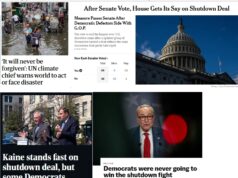by Will Driscoll
A “building ambassador” who lives in an apartment or condominium building can bring voter registration to their neighbors in the building and, later, election messaging.
In this interview, Richard Skinner describes how he recruits and works with building ambassadors to reach voters in the 62% of Arlington housing units that are apartments or condominiums (according to U.S. Census data). Mr. Skinner serves as Vice Chair for Multi-Unit Building Outreach for Arlington Democrats.
Will Driscoll: Richard, suppose I’m enthusiastic about an upcoming election and I want to speak with voters face to face in an apartment or condominium building. How hard would that be if I don’t live in the building?
Richard Skinner: It could be quite difficult, because a lot of buildings in Arlington have restricted access. You know, the front door obviously could be locked; some of the higher-end buildings have concierges, and so on. So, that is quite difficult.
Will Driscoll: I hear from an Arlington office-holder that many Democrats who live in those buildings have been recruited to be building ambassadors. How did you decide to lead this recruiting process?
Richard Skinner: We have been doing this since 2006. I became active in the county party in 2016, and in 2017 I was asked by my precinct captain to be a building ambassador—we have a very well-organized precinct here. So I took over as building ambassador with my wife. We ran a series of events here, and I had some success in registering people to vote. Then, after the 2017 election, I was asked to take over the building program overall, since I had expressed interest in this particular area. So I’ve been running it for about a year.
Will Driscoll: And what exactly does a building ambassador do?
Richard Skinner: They do a number of things. Obviously, they represent the county party in the building. They’re there to manage events. Probably the most common event we do is voter registration, and we do that in collaboration with the people who run voter registration for the party. That is particularly appropriate for these buildings, because a lot of these buildings have high turnover.
And one of the reasons we target multi-unit buildings in Arlington is that the population there tends to be a little tougher to turn out, because it tends to be younger; it tends to be more transient; in some parts of the county it’s more culturally diverse. So voter registration is particularly important there because in every building, you have a lot of newcomers.
Like in our building—we live in a condo building—and so our voter registration events usually get a handful of people we need to register, because there aren’t that many people who are new to the building every few months.
On the other hand, in some of the buildings in the more transient parts of the county—that would be basically the metro corridors—you can get quite a few more, because there are more people who are new there.
And so that’s our biggest thing we do—voter registration; it’s not terribly difficult to do. And we have a really long list of voter registration volunteers out there.
The other thing we do is, we encourage ambassadors to let people in their building know about upcoming events. That could be primary day, that could be election day, it could be voter registration deadlines, or opportunities to volunteer. They usually will post those in their building. For election day, we usually include information on their polling place and so on.
And then we also encourage them to post them in their building communities, as a lot of the larger buildings have online communities of one kind or another and we can let people know that way.
And then in a few buildings we did candidate visits this year. It was really, really important this year for the county board race. That was a real priority for Matt’s campaign [Matt de Ferranti, now an Arlington County Board member]—getting into the multi-unit buildings—because essentially we know that the people in the buildings are less likely to vote; when they do vote, they vote heavily Democratic; and they’re often not really involved in local politics at all.
So really our goal in 2018 was turning those people out to vote, in a big way. And so we did a number of events really just aimed at getting Matt and other Democrats into those buildings.
Will Driscoll: That’s great; that’s terrific. Do you have any idea why people in Arlington have stepped forward, perhaps even more so recently, to take on that role?
Richard Skinner: Sure. I think some of it has been my own recruiting. I’ve been doing a lot of recruiting usually earlier in the year, before we have a lot of events, trying to list some of the largest buildings in the county and trying to fill those holes where we have buildings where we need somebody, but we don’t have anybody.
When people have stepped forward, I think a lot of it is because of the situation in national politics. I think there are a lot of people who are looking for some sort of meaningful way to contribute. And I think for a lot of them, getting involved in local politics is a way of doing that, in a way that feels a little more tangible.
In 2017, we turned out a lot of people for the governor’s race who were really motivated by national politics and probably had never voted in a governor’s race before, and that was the same with the U.S. Senate and county board elections last year.
Will Driscoll: And what do building ambassadors say about the experience of doing that work? What do they like about it?
Richard Skinner: I think a lot of it just seems to be a way to meet their neighbors, a good way to represent the Democratic Party in their building. A lot of them are quite aware that their buildings are hard to reach. If you’ve ever been canvassing in a place like Arlington, it’s frustrating, because there are so many people you can’t talk to, and I think people are more aware of that. It’s a good way to reach people that might not otherwise be reached.
And it’s a way to meet your neighbors. I’ve had people who were new to their building who helped with our voter registration events. It just simply was a nice way to chat up people in the lobby. Certainly in a lot of these big buildings you’re kind of anonymous when you first move in, and this is a way that people can meet their neighbors—people who would otherwise, you know, pass by them in the hallways.
Will Driscoll: Does the work of a building leader always focus around campaign season, or do some building ambassadors continue to reach out to their neighbors in their building throughout the year?
Richard Skinner: We would like to do more of that. Maybe in a couple or a few buildings, maybe we could start building core groups of activists. That’s something we’d like to work on this year and in the future.
The heaviest part of the work tends to be in the summer and fall. We’re trying to do some voter registration in the spring, but it tends to be concentrated closer to the election.
But even if we do voter registration in March and April, you’re getting people on to the rolls who will then be eligible to vote in the primary, and then could be voting in the general election. You know, who knows how long they’ll live in that building, they’ll be registered for all that time.
Will Driscoll: Are there any stories about the success of this work in a particular building that stand out in your mind?
Richard Skinner: We did one event in one of the buildings in Crystal City where I think we registered 15 or 20 people. So that’s an example of success.
In the past two cycles, we’ve really had very nice turnout in the neighborhoods with a lot of multi-unit buildings, so I think that’s a sign that what we’re doing is effective.
Will Driscoll: Is there anything we missed that comes to mind?
Richard Skinner: Well, I think this is something that could be applied in other communities in Virginia. I’ve already had discussions with people in the Alexandria Democratic Party. I think in the City of Richmond, it would make a lot of sense. Simply any place where you have a lot of high-rise buildings that are not accessible for canvassing.
That was really the germ of what Jill did with this project [that’s Jill Caiazzo, Chair of Arlington Democrats]. It was really all about realizing that we missed a lot of people through canvassing, and that we needed to find some way to do some kind of outreach.
Now there are other forms of outreach that we’re doing. We’re doing more and more social media. I think that is a really effective way to reach the people in those buildings, both because it can get around the canvassing problem, and because the people who live in those buildings tend to fit the demographics of people who are really, really into social media.













